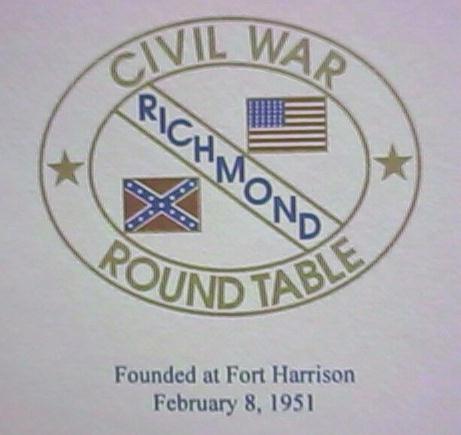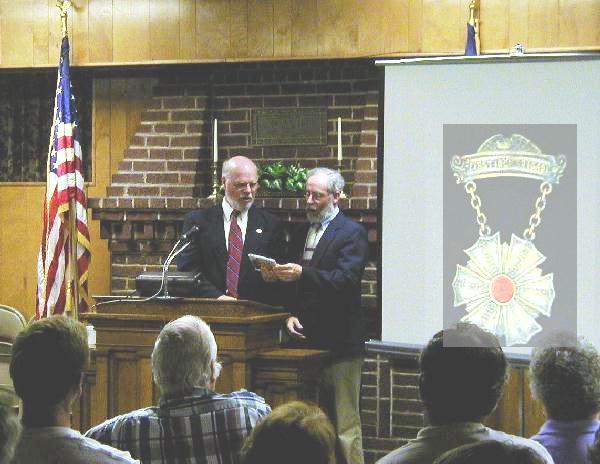


August 2000
R.Danny Witt, President Art & Carol Bergeron, Editors 5500 Ashton Park Way 3901 Paces Ferry Road Glen Allen, VA 23059 Chester, VA 23831-1239 August 2000 PROGRAM James L. Conrad "The Confederate Naval Academy" 8:00 p.m., Tuesday, August 8, 2000 Boulevard United Methodist Church, 321 N. Boulevard, Richmond, VA (corner of Boulevard and Stuart Ave.) Enter basement door from Boulevard side. Colonel James Lee Conrad, United States Air Force, will speak on the history of Richmond's Confederate States Naval Academy and the training of Rebel midshipmen. Colonel Conrad is the author of Rebel Reefers: The Midshipmen of the Confederate States Naval Academy, which will be published next summer by Savas Publishing. The presentation will cover the founding of the Confederate States Naval Academy, the life of Confederate midshipmen both on the school ship and aboard warships, their wartime service on and off the school ship, including the escorting of the Confederate treasury from Richmond and the final fate of the Naval Academy and its midshipmen. Colonel Conrad is currently the Staff Judge Advocate for the 88th Air Base Wing at Wright-Patterson Air Force Base. He is a 1978 graduate of the Virginia Military Institute, a 1981 graduate of the Cumberland School of Law (Juris Doctorate), and a 1993 graduate of the George Washington University Law School (Master of Laws in Environmental and Government Procurement Law.) He is the author of The Young Lions: Confederate Cadets at War, which was published in 1997 by Stackpole Books. Conrad has had numerous articles published in Civil War Times Illustrated, America's Civil War, Military History, and Columbiad, as well as an entry in Simon & Schuster's Encyclopedia of the Confederacy. Conrad will have available for purchase at the meeting copies of his book The Young Lions.
Thomas G. Clemens "Will the Real Iron Brigade Please Stand Up!" Review of the July Program Tom presented an informative talk on "Will the Real Iron Brigade Please Stand Up!" The talk focused on who was really entitled to the nickname "Iron Brigade" and how some commonly held beliefs about the unit are not completely supported by the historical record. The standard story is that Brigadier General John Gibbon commanded the Iron Brigade and that it was composed of the 2nd, 6th, and 7th Wisconsin, 19th Indiana, and 24th Michigan Infantry regiments. Its nickname resulted primarily from its fighting abilities as demonstrated at the Battle of South Mountain. According to legend, Major General George B. McClellan asked Major General Joseph Hooker for an "iron brigade" to pierce the Confederate center that day, and Fighting Joe sent forward Gibbon's men, who had been known as the "Black Hat Brigade" because of their distinctive Hardee hats. The general's continued in conversation during the battle, and both of them used the term "iron" in describing the men. Actually, Gibbon's was not the first, nor the only, brigade to have this title. As Clemens pointed out, this entire tale is based primarily upon a story by W. H. Atkins, which appeared in the veterans' publication The National Tribune in 1904. None of the generals mentioned by Atkins were still alive at the time to refute his account. Hooker had not been with McClellan at the time and had not even witnessed Gibbon's men in action. After the war, Gibbon was asked about the sobriquet, but he could not recall when it had been applied to his brigade but thought it was shortly after the Battle of Antietam. A unit of New Yorkers, the 1st Brigade, 1st Division, First Corps, was the original Iron Brigade. Composed of the 22nd, 24th, 30th, and 84th (14th Brooklyn) regiments, this brigade was commanded originally by Brigadier General Christopher C. Augur. In March 1862, while on a raid in central Virginia, the men made a long and difficult march. Brigadier General Marsena Patrick, who saw them coming into camp, said to Augur, "Your men must be made of iron to make such marches." From this time until the regiments were mustered out of the army in the fall of 1862, the 1st Brigade, 1st Division, First Corps, was known as the Iron Brigade. Clemens shared some of the strongest evidence supporting this brigade's claim to the nickname. The papers of Colonel Walter Phelps, Jr., of the 22nd New York, contain a number of references to the term in his letters and diaries. There are also several relics that bolster this position. Badges were made up for the brigade's members, and they contain the name Iron Brigade and a list of the regiments in it. Several years ago, a relic hunter found one of the metals while digging near Fredericksburg. A flag carried by the 24th New York Infantry is preserved in the state capital in Albany. One side of the banner has the words "24th Regiment, Iron Brigade, 1st Division, 1st Army Corps." Finally, Captain Austin W. Holden, assistant surgeon of the 22nd New York, wrote a song dedicated to Colonel Phelps called "A Song of the Iron Brigade." During the course of the Civil War, several other units called themselves the Iron Brigade. Included were the 3rd Brigade, 1st Division, Third Corps (17th Maine, 3rd and 5th Michigan, 1st, 37th, and 101st New York) and Brigadier General Jesse Reno's brigade of the Ninth Corps (21st and 35th Massachusetts, 51st New York, and 51st Pennsylvania). Clemens concluded by saying that, while Gibbon's "Black Hats" are the most famous Iron Brigade, more than one unit can claim the nickname and that we must be careful not to accept too readily some of the famous stories that have come out of the Civil War.
A Louisianian's Recollections of the Confederate States Naval Academy "...I received my orders, and instead of being sent to an ironclad I was ordered to report on board of the schoolship Patrick Henry to be examined for promotion. Most of my classmates had been nominally taken out of active service and put to school while I was at sea, and they were now passed midshipmen. I had not opened a schoolbook since I had left Annapolis, and the result was that I failed to pass. But I was given another chance and had to begin school again. Although I did not know it, if there was one thing that I needed more than anything else, it was a little schooling." "There were about sixty young midshipmen on the Patrick Henry, varying in age from fourteen to seventeen. Their jackets were made out of very coarse gray cloth and the food they had to eat was, at first, revolting to me. The menu offered little variety. If it was not a tiny lump of fat pork, it was a shaving of fresh meat as tough as the hide which had once covered it, with a piece of hardtack and a tin cup of hot water colored by chicory or grains of burned corn, ground up, and brevetted coffee. But no one kicked about the food, as it was as good if not better than that the poor soldiers in the trenches received. The James River furnished a capital article of chills and fever not malaria, but the good old-fashioned kind with the shivers which made the teeth chatter and burning fever to follow. On an average about one half of the midshipmen went through this disagreeable experience every other day. No one was allowed to go on the sick-list on account of chills and fever; one was, however, allowed to lie down n the bare deck while the chill was on, but had to return to duty as soon as the paroxysm was over." From: Recollections of a Rebel Reefer, by James Morris Morgan (Boston: Houghton Mifflin Company, 1917), pp. 205-207
Announcements Upcoming Symposium. Pamplin Historical Park & The National Museum of the Civil War Soldier, near Petersburg, will hold its Fourth Annual Civil War Symposium on October 21-22. The theme this year is "Cavalry Raiders and Guerrillas." Speakers and their topics are: Stephen Davis, "Civil War Cavalry Raids: Just What Did They Achieve?" Edwin C. Bearss, "Wilson's Alabama Raid" Jeffry D. Wert, "Mosby's Rangers" James A. Ramage, "John Hunt Morgan" Brian Steel Wills, "Nathan Bedford Forrest" In addition to these fine talks, the symposium will include a tour of Jeb Stuart's famous "Ride Around McClellan" in the Spring of 1862. For a registration form or more information, call Pamplin Historical Park at 861-2408.
Richmond Civil War Round Table in Cyberspace. The Round Table's Web site has been available for several months. It includes the monthly newsletter, photographs of previous meetings, and a list of all forthcoming speakers. The URL or Web address is: http://members.tripod.com/~g-cowardin/rcwrt (The - between g-co is an underscore )
*Important Notice* December Meeting The December meeting will be December 12, 2000, at the Holiday Inn-Crossroads, 2000 Staples Mill Road. Social hour will begin at 6 p.m., with dinner following at 7 p.m. The speaker is Ed Bearss who will speak on "The Raising of the Cairo," which will include information about the history of the Union ironclad. The cost for this program is $25.50 per person. Seating is limited, so please get your reservations in early. Send your name, address, and phone number, along with the number of persons for whom you are making reservations to Sam Craghead. Make your check out to the Richmond Civil War Round Table. Sam Craghead 4361D Lakefield Mews Richmond, VA 23231 If you have any questions, call Sam at 222-0503.
Richmond Civil War Round Table Newsletter Art & Carol Bergeron, Editors 3901 Paces Ferry Road Chester, VA 23831-1239
Return to News Letters Index
Return to main page

©R.C.W.R.T. 2000
